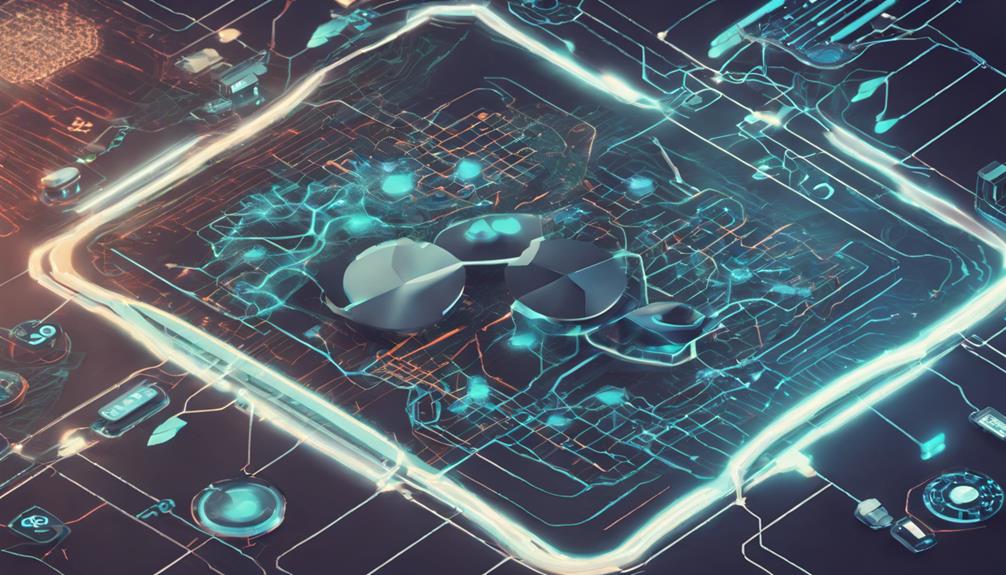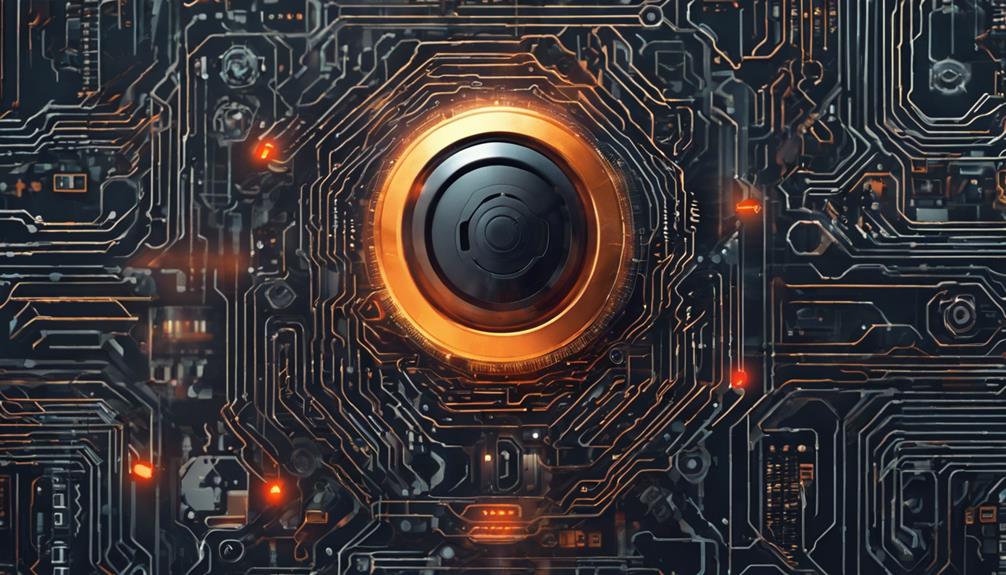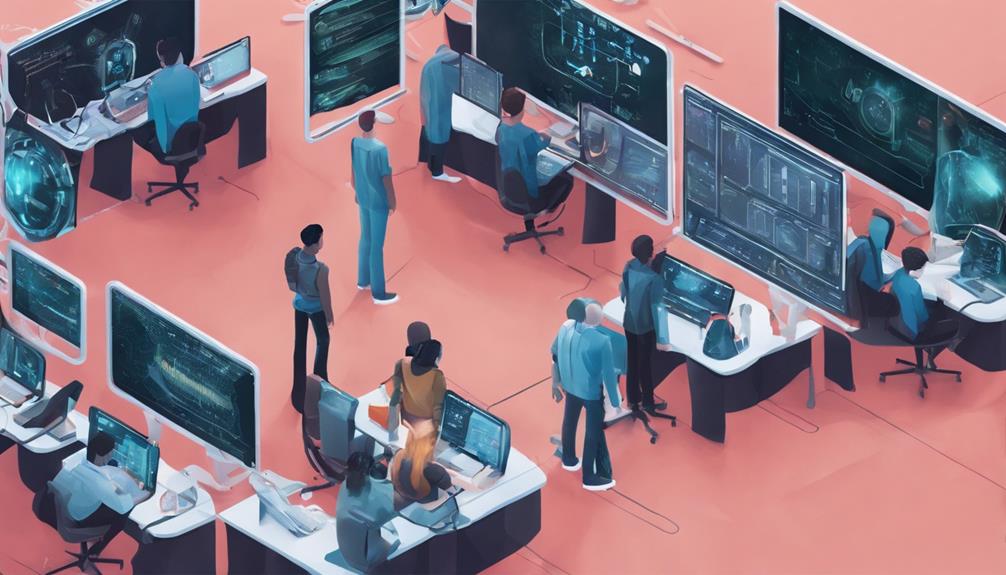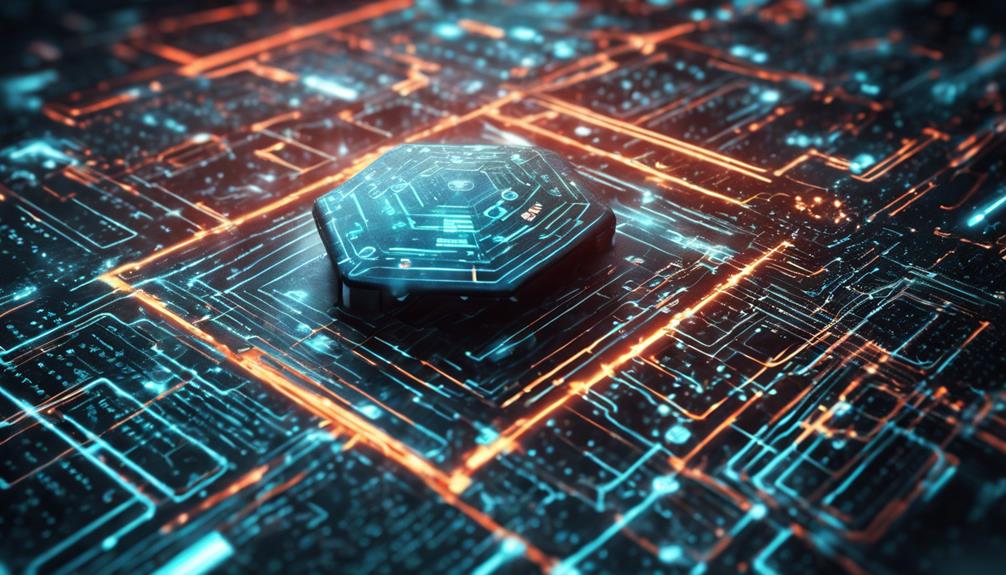Master the strategic use of AI in cybersecurity to defend against cutting-edge threats. AI enhances threat detection accuracy, offers real-time monitoring, and automates routine tasks to boost efficiency. Deep learning techniques empower proactive security monitoring and detection of anomalies, ensuring a resilient defense against evolving cyber threats. Learn to fortify your cyber defenses, evolve incident response, and excel in risk management. Equip yourself with the skills needed to safeguard digital assets effectively and combat sophisticated adversaries. Unravel the domain of cybersecurity excellence through AI integration and stay ahead of modern threats. Up your cybersecurity game with AI!
Key Takeaways
- AI courses focus on threat detection and response strategies.
- Learn to analyze data for security risks and anomalies.
- Develop skills in combating evolving cyber threats effectively.
- Understand how AI strengthens cybersecurity defenses through deep learning.
- Gain knowledge in implementing AI for proactive monitoring and real-time threat detection.
Importance of AI in Cybersecurity
The utilization of Artificial Intelligence (AI) in cybersecurity plays a crucial role in enhancing threat detection and response capabilities. AI algorithms empower security systems to conduct real-time monitoring, processing extensive data volumes to swiftly detect potential threats.
Machine learning enables adaptive defense mechanisms to evolve and combat novel attack patterns effectively. Incorporating AI with data analytics provides deep insights into security status and risk management, facilitating informed decision-making.
One of the significant advantages of AI in cybersecurity is the enhancement of incident response through contextual understanding. By analyzing patterns and anomalies, AI systems can quickly identify and mitigate security breaches, minimizing potential damages. This contextual understanding allows security professionals to respond efficiently to threats, safeguarding systems and data effectively.
In the domain of cybersecurity, AI serves as a powerful ally, enabling organizations to stay ahead of malicious actors and protect their digital assets with precision and agility.
Benefits of AI Integration

Utilizing AI integration in cybersecurity offers a myriad of advantages, ranging from enhancing threat detection accuracy to automating routine tasks for improved operational efficiency. Artificial Intelligence (AI) plays an essential role in strengthening cyber defenses by analyzing data, identifying anomalies, and responding to threats promptly. By harnessing Machine Learning capabilities, AI-powered systems can efficiently scan devices for vulnerabilities, prioritize risks, and enhance overall security posture. This intelligent technology enables organizations to detect and respond to cyber threats faster than traditional methods, ultimately reducing the risk of security breaches. Additionally, AI automates repetitive tasks, leading to cost savings and increased productivity within cybersecurity operations. The table below summarizes key benefits of AI integration in cybersecurity:
| Benefits of AI Integration | Description |
|---|---|
| Enhanced Threat Detection | AI analyzes vast amounts of data for anomalies, improving threat detection. |
| Automated Routine Tasks | AI automates tasks, reducing costs and enhancing operational efficiency. |
| Faster Response to Threats | Behavior analysis with AI aids in detecting and responding to threats swiftly. |
| Risk Identification & Prioritization | AI helps identify and prioritize risks, enhancing overall security. |
| Improved Vulnerability Scanning | AI-based solutions provide accurate and efficient scanning for vulnerabilities. |
AI for Threat Detection

AI applications in cybersecurity for threat detection leverage advanced algorithms to analyze data and identify potential security risks. By utilizing machine learning and artificial intelligence, these systems can effectively detect cyber attacks in real-time through continuous monitoring and behavior analysis.
The AI algorithms sift through vast amounts of data to pinpoint anomalies that may indicate security breaches, allowing organizations to proactively address threats before they escalate.
One of the key advantages of AI-powered threat detection is its ability to provide proactive monitoring, enabling the identification of suspicious activities and potential vulnerabilities before they are exploited. This proactive approach greatly enhances security posture by eliminating the reliance on outdated signature-based detection methods.
Leveraging Deep Learning Techniques

Deep learning techniques play a pivotal role in enhancing the sophistication of cybersecurity defenses through their ability to analyze intricate data patterns for threat detection.
By leveraging neural networks and deep learning algorithms, cybersecurity professionals can effectively identify cybersecurity risks, anomalies, and potential security breaches. These advanced defense mechanisms enable the continuous learning and adaptation of systems to combat evolving cyber threats.
Deep learning models excel at processing vast amounts of data, making them invaluable in detecting even the most subtle signs of malicious activity. In cybersecurity courses, the integration of deep learning not only deepens understanding but also equips learners with practical skills to fortify defenses against modern cyber threats.
As the cyber landscape becomes increasingly complex, embracing deep learning in cybersecurity is paramount to staying ahead of cybercriminals and safeguarding sensitive information. By mastering deep learning techniques, individuals can proactively defend against sophisticated cyber attacks and contribute to creating a more secure digital environment.
Future Trends in AI Security

In looking ahead to the future of cybersecurity, the integration of AI with cutting-edge technologies is poised to revolutionize the landscape of security defenses. Artificial Intelligence (AI) is at the forefront of reshaping cyber defense strategies to combat evolving cyber threats.
Self-learning algorithms enable real-time threat exposure and response, enhancing the ability to detect and contain attacks swiftly and accurately. AI in cybersecurity is not just about reacting to incidents but also about strategic planning and proactive measures based on user behavior analysis and data science.
The future trends in AI security involve leveraging AI's capabilities to fortify existing security infrastructure and stay ahead of sophisticated cyber threats. By incorporating AI into security protocols, organizations can bolster their defenses, ensuring a resilient and robust cybersecurity posture against modern adversaries.
Embracing AI in cybersecurity is key to remaining agile and adaptive in the face of ever-changing threat landscapes.
Implementing AI in Cyber Defense

Improving cyber defense capabilities through the integration of advanced algorithms for real-time threat detection is vital in the current landscape of cybersecurity. Implementing AI in cyber defense processes enhances the ability to detect and respond to threats promptly, reducing the potential impact of breaches.
By automating incident response and implementing adaptive defense systems powered by AI, organizations can benefit from continuously learning and adjusting to emerging threat patterns. Data-driven risk management and incident response with AI provide actionable intelligence, enabling proficient risk mitigation strategies.
AI cybersecurity courses play an essential role in equipping individuals with the necessary skills to defend against modern threats using advanced AI technologies. By understanding how to leverage AI for real-time threat detection, automating incident response, and implementing adaptive defense systems, cybersecurity professionals can enhance their organizations' defense mechanisms against evolving cyber threats effectively.
Strengthening Incident Response With AI

Utilizing artificial intelligence (AI) in incident response processes greatly enhances organizations' ability to detect and respond to security threats swiftly and effectively. AI-powered systems play an essential role in strengthening incident response capabilities, offering a range of benefits:
- Improved Context: AI provides enhanced context for prioritizing and responding to security incidents efficiently.
- Fast Response: AI enables rapid response to security alerts by identifying and addressing root causes while mitigating vulnerabilities.
- Proactive Prevention: By incorporating AI in incident response, organizations can proactively avoid future security issues with increased efficiency.
- Automated Tasks: SmartDev leverages AI for threat detection, response, and prevention, automating routine cybersecurity tasks and ensuring a more efficient incident response process.
With AI models continuously evolving to adapt to new threats, organizations can achieve unparalleled efficiency in incident response, staying ahead of emerging cybersecurity challenges and protecting sensitive data effectively.
Addressing AI Security Challenges

AI's integration in cybersecurity initiatives faces significant hurdles, including adversarial attacks exploiting vulnerabilities and challenges in machine learning integration. Adversarial attacks manipulate AI systems by injecting false data, creating vulnerabilities that can be exploited by cyber threats. Additionally, the current skill gap in effectively integrating machine learning into cybersecurity processes impedes the full potential of AI-powered defenses. Regulatory compliance is important to guarantee that AI security solutions meet industry standards and legal requirements. Ethical considerations, such as preventing bias in AI algorithms, are essential for the responsible use of AI in cybersecurity. Data privacy concerns also play a critical role, as AI algorithms rely on vast amounts of data, necessitating careful handling to protect sensitive information. Addressing these challenges is necessary for robust cybersecurity implementation that effectively mitigates vulnerabilities and safeguards against modern threats.
| AI Security Challenges | Key Points to Address |
|---|---|
| Adversarial Attacks | False data injection, vulnerability exploitation |
| Regulatory Compliance | Legal standards, industry regulations |
| Ethical Considerations | Bias prevention, ethical AI usage in cybersecurity |
| Data Privacy | Protection of sensitive data, responsible data handling |
Frequently Asked Questions
How Does AI in Cybersecurity Help Prevent Threats?
AI in cybersecurity aids threat prevention by leveraging real-time monitoring to detect nuanced malicious activities, automating incident response for swift action, adapting to novel attack patterns, and providing deep insights into security status for proactive risk mitigation.
What Are Some Examples of AI in Cyber Security?
Examples of AI in cybersecurity include behavioral analytics detecting anomalies, predictive analytics forecasting attacks, and automated response isolating threats. These technologies enhance defense strategies, response capabilities, and security posture against evolving cyber threats.
Is AI Going to Replace Cyber Security?
AI is not going to replace cybersecurity professionals; rather, it will complement their roles. While AI can automate tasks and improve threat detection, human experts remain critical for strategic decision-making and handling complex cybersecurity challenges effectively.
How Much Does a SANS Course Cost?
Investing in a SANS course can range from $5,000 to $7,000. Discounts are offered for early registration, group bookings, and government/military personnel. Additional costs like exam fees may apply. SANS courses provide excellent cybersecurity training.
Conclusion
In summary, the integration of AI in cybersecurity courses is vital for defending against modern threats. By leveraging deep learning techniques, implementing AI in cyber defense, and strengthening incident response with AI technology, professionals can stay ahead of evolving cyber threats.
While some may be hesitant to embrace AI due to security challenges, the benefits far outweigh the risks. Embracing AI in cybersecurity education is essential for preparing individuals to effectively combat cyber threats in the digital age.









